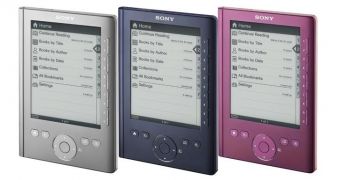Sony has been going through some substantial changes as of late. The company sold its 18-year-old VAIO PC business, claiming that it planned to refocus its efforts on its tablet and smartphone business instead.
However, apart from the two categories mentioned above, Sony was also making eReaders. In this context, back in February, it was announced that Sony was all but willing to pull the plug on its unprofitable US eReader business.
Now, several months after the announcement, the company says it will not be offering another eBook reader product. Ever. As The Digital Reader reports, Sony will be renouncing eBook readers for good and will not be launching such devices even in its home market, Japan.
According to the latest information, the Sony PRS-TR3 is now discontinued, and when the device stocks run out, they will not be replenished. Plus, a new model will not be making its way onto the market.
After selling its VAIO line to a Japanese company, it’s no wonder Sony is trying to get rid of its unprofitable businesses and focus on what’s actually working for them.
eReader sales have been experiencing a consistent downfall ever since tablets became popular. The exception to the rule might be Amazon’s Kindle digital readers, which have somehow miraculously escaped the cannibalization.
That’s probably because products such as the Kindle Paperwhite offer a high-contrast grayscale display that allows users to read in direct sunlight. And many tablets today have a problem with sunlight readability.
Not to mention that eReaders tend to consume a lot less power, so they can last up to weeks or even months of use on a single charge. Which is quite convenient for those who don’t have a power source at their disposal all the time.
At this point, we should highlight an interesting fact. Sony was the first company to launch an E-ink eReader, in the form of the Librie, back in 2004. The tech giant worked hand-in-hand with E-Ink and Toppan Printing Co. of Japan and finally managed to push out the first-gen 6-inch screen that the Librie made use of.
The tech was then taken up and used by competing companies, being implemented in products such as the Nook and Kindle.
That’s not the only innovation Sony contributed with to the eReader ecosystem. For example, the company was the first to adopt the Epub format, which was compatible with the PRS-700, launched back in 2008.
However, as the years passed, Sony got overshadowed by companies like Kobo, Amazon, or Barnes & Nobles, which offered their competing devices at much cheaper prices and Sony just couldn't keep up.
We should keep in mind though that Sony’s eReader business managed to keep afloat for ten years, which isn't half bad. Other tech giants fared much worse in the eReader business.
For example, Samsung introduced three products back at CES 2010, but they sold so miserably that the Korean device maker had to discontinue them two years later.

 14 DAY TRIAL //
14 DAY TRIAL //